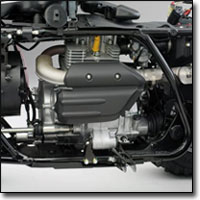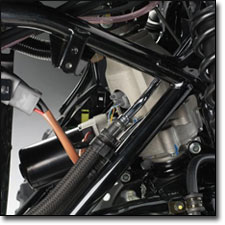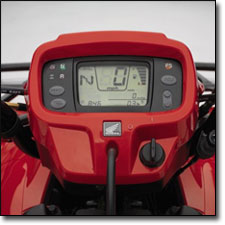Torrance, Ca (12/28/06) - With the
introduction of the Foreman(R) 4x4 with Electric Power
Steering (EPS(TM)), Honda has once again added an innovative
twist to an industry benchmark-the Foreman line of ATVs.
As one of the best-selling ATVs in history, it was
a daunting task to re-create the Foreman in 2005.
For months, Honda R&D personnel spent countless
hours visiting ATV owners across the country to see
how they put their machines to work in a myriad of
ways, under an unimaginable variety of conditions:
deep mud, freezing temperatures, snowy conditions,
dusty farm usage, towing trailers and other work implements,
running up and down hills-under all kinds of real-world
situations, many of which expanded Honda's notion
of tough usage. From this, engineers drew a bead on
where they wanted to go with the next-generation Foreman.
The New Machine Takes Shape
Of course, increased performance was a given expectation
in both the engine and chassis departments. Introduced
in 1998, the Foreman 450 engine had been derived from
the 395cc Foreman powerplant, which dated back to
1995. While each had been a masterful stroke in its
time, the new Foreman was due for an all-new engine,
and the natural course pointed toward a 500-class
machine.
 |
The
new 475cc Poweplant of the Honda Foreman 500
4x4 ATV produces about 15 percent more power
than its precursor. |
In 2005, Honda engineers gave the Foreman an all-new,
air-cooled, longitudinally mounted OHV engine featuring
an entirely different cylinder head configuration
and valve arrangement. Feeding this combustion chamber
is a 36mm carburetor (up from the previous engine's
32mm mixer) with a throttle position sensor for increased
response and performance all through the rev range.
This engine features the convenience of electric starting,
but with the 500 the starter also operates when the
machine is in Reverse for even more ease of operation.
This powerplant is also blessed with a five-speed
gearbox with Reverse, plus a larger, beefier clutch
to handle the increased power output.
Displacing 475cc, the current Foreman engine is only
9.6 percent larger than the 433cc engine used in the
TRX450, yet it churns out about 15 percent more power
than its precursor. And it's not just the quantity
of the Foreman's power that sets it apart. This engine
is distinctly freer-revving than the previous engine,
which gives greater performance and a big boost in
the fun-factor department.
Taking the Foreman Chassis Upscale
Naturally, this 500-class engine was housed in a larger,
more sophisticated chassis. To accomplish this upward
transition, the Foreman borrowed heavily from Honda's
renowned workhorse, the FourTrax(R) Foreman Rubicon(TM).
As a result, the TRX500 features a wider track front
and rear compared to the 450, and it has grown 1.5 inches
in overall width to tape out at 46.8 inches. It stretches
to 83 inches in overall length, almost 6 inches longer
than the TRX450, over a wheelbase of 50.7 inches compared
to the former machine's 50.2-inch wheelbase.
Making It Better, Making It Smarter
The Foreman 500 boasts a fuel capacity of
4.2 gallons; that's a full gallon more than the 450
used to hold. Dual front disc brakes add significantly
to the 500's stopping power. These disc brakes feature
collet-style brake calipers that are self-centering,
and the calipers also feature integrated scrapers
that eliminate buildup of debris such as mud or ice
that might otherwise impede their stopping capacity.
The 500 also enjoys large rear drum brakes, which
measure 180mm in diameter versus the 160mm drums used
on the 450. Knowing that Foreman ATVs are often subjected
to heavy-duty tasks in extreme mud conditions, the
engineers devised a dual oil-cooler system, with the
second cooler mounted high in the fender area where
it won't get clogged with mud over the course of a
long, soggy day's work. Naturally, this bright-think
idea for extra cooling is patented, so you'll see
this great idea appear only on the TRX500.
 |
|
 |
The
Electric Power Steering unit on the Foreman
450 ATV |
|
The
Foreman 450 is equipped with a very informative
Dash to keep the rider in the know at all times. |
For 2007, the Foreman's suspension was juggled to
accommodate the demands of EPS. Many hours were spent
developing shock valving that specifically meets the
handling demands of EPS. The high-quality Kayaba shocks,
which deliver 6.7 inches of travel front and rear,
feature increased spring and damping rates in front
and stiffer springs in the rear. The result is a noticeably
plush ride that perfectly complements the EPS system,
especially in rough conditions.
Other Foreman Innovations
The Foreman with EPS also features four-wheel-drive
with Honda's acclaimed Electric Shift Program (ESP(TM))
for push-button shifting. The four-wheel-drive system
features Honda's lighter, smaller, new-generation version
of TraxLok(R), which enables the rider to shift between
2WD and 4WD with the simple flick of a switch.
The Proof Is in the Riding
Once again, the 2007 FourTrax Foreman 500
with EPS is positive proof of Honda's commitment to
ongoing progress and innovation. With the introduction
of EPS, Honda has revolutionized the ATV riding experience
and launched the entire ATV industry into the future.

www.honda.com














